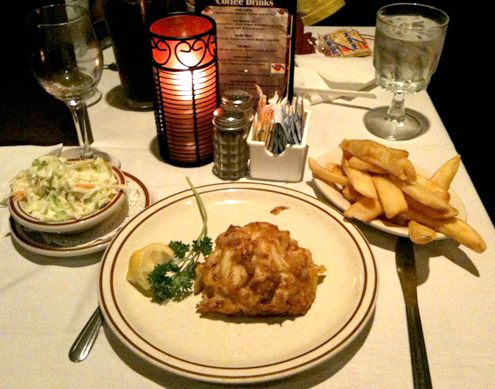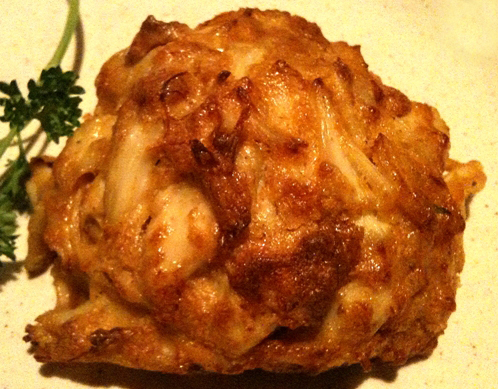
For the past 30 years I have been meatless and guiltless. Yet over the past couple of years I have begun to slip, to stray. I am off the meatless wagon. I can finally admit that I am an invertebratarian. I consume animals without a face, a mother, or a backbone.
What is in the invertebrate mix? Shrimp. Crab. Oysters. Bamboo grubs in China. Fried grasshoppers in Mexico. No backbone, no problem.
Woodrow (my younger grandson) and I finished our DC trip last week back at BWI. We could not make the last flight home on Wednesday, so we stayed at the airport and left early Thursday morning. A night at BWI means only one thing to us invertebratarians – G&M crab cakes in Linthicum.
In the late 1970s I lived in Columbia, Maryland, for a year. Being pre-Virginia, I enjoyed all of the Maryland coast seafood I could ingest. I lunched on crab soup each afternoon at the Lexington Market. I would count the days until the soft shell crab season on the Eastern Shore. And what can compare to a plate of steamed blue crabs on butcher paper with a pitcher of brew?
I also discovered Maryland crab cakes. Not the Gulf coast kind of my childhood, a flattened patty of filler with a smattering of crab. Maryland crab cakes are constructed of fresh crab meat with only enough binder to hold the mound from toppling.
There are three restaurants in the Baltimore area that serve authentic Maryland crab cakes (or at least three that I have found). One is in Dundalk, one near Harborplace (Little Italy), and the best, in my opinion, is in Linthicum.
You judge a crab shack first by the clientèle. Is there a waiting list (leave if the answer to the first question is no). Are most of the people in the restaurant curvilinear? Is there a healthy mix of ethnicities? Is the average age of a waitress over 60? Is the Baltimore or Eastern Shore accent so dense that you need a translator? If the answer to all of these is yes, you are in for a treat.
G&M is the iconic Maryland crab cake restaurant. All others are measured against G&M. Although G&M expanded a few years ago, you should insist on eating in one of the original dining rooms. Notice that the decor is decidedly ’50s. The flowers on the table are fake, the art on the walls is from the Walmart gallery, and within five minutes of being seated you will hear Dean Martin on the jukebox. Perfect!

Also notice that I said blue crab. I know that snow crab makes good television, but the lack of character (i.e., it has no taste) leaves it unsuitable for human consumption. Snow crab is the tofu of crustaceans. Having no taste of their own, snow crabs depend on the sides and sauces.
In a few days I will be in Boiling Springs (PA) to talk about place. Food is a forceful shaper and definer of place. If I want red or green chili, I go to Hatch or Las Vegas (NM). If I crave lobster (no face, no mother, no backbone), I wait until my next trip to MA up to ME. A bowl of Tarascan soup? Patzcuaro (Michoacan, Mexico). Shima tofu? Okinawa. June berry pie? Walhalla, North Dakota. Pu’er tea? Dali (China). Fried okra? Virginia or Mary Eubanks, Austin, Texas.
Yes, we are what we eat. But we are also who we eat. Traditional foods tether us to our past, to our heritage, and to our family. Languages are adopted, clothes changed, even names transformed, but foods are passed from generation to generation as a reminder of those who came before, and therefore of who we are. Food heritage (such as in heirloom vegetables) is on the up-swing, and for the most obvious reasons. Have you tried to gag down a hothouse tomato? Now you understand the slow food movement, and why so many are interested in supporting local growers.
Eat what you are, where you are, who you are.
Ted Eubanks
11 April 2010